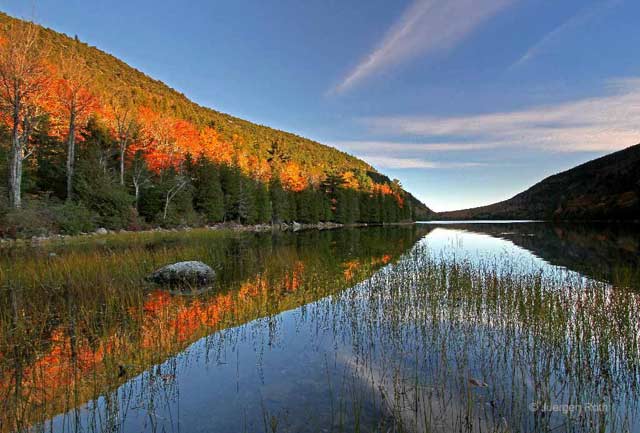
Maine Fall Foliage – Glory at Bubble Pond; Camera settings f/11, 1/6 sec., ISO 100
We started our travels in Maine’s Acadia National Park in Part 1 by learning about the towns, Jordan Pond and the Park Loop Road. We continue on by making one more stop on the Park Loop Road at Bubble Pond before taking the winding roads up Cadillac Mountain for grand sunrise or sunset vistas. From here we turn away from the main park and make our way to other park highlights on Mount Desert Island. Some of these locations are a bit off the beaten path, but reward with exceptional nature photography opportunities.
Bubble Pond
Back on the road and only a short drive from the Jordan House parking area, the park loop road will lead to Bubble Pond. This location provides brilliant and pristine autumn foliage around its shoreline. The waters of the pond are still and beautiful reflections are possible. Wildlife is thriving. Be sure to not only look in the woods, but keep your eyes on the pond and you may just encounter an otter frolicking in the last light of the day. Loons and Mergansers reside in the area too.
Photo Tip:
Use your polarizing filter to saturate colors and eliminate unwanted glare on leaves and wet surfaces.
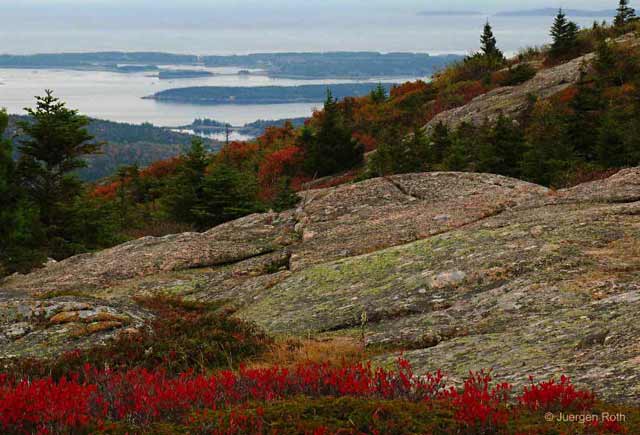
Frenchman Bay; Camera settings f/7.1, 25 sec., ISO 100
Cadillac Mountain
Cadillac Mountain Summit Road is a 3.5 mile drive up to the top of Cadillac Mountain where one enjoys spectacular 360 degree views of Bar Harbor, Frenchman Bay, and Cranberry Island to the East and Eagle Lake and Mount Desert Island to the West. There are many photographers at this location so be here early during sunrise or sunset to secure your spot. Alternatively explore the mountain top to find your own unique photo spot and composition. Sunsets provide majestic views to the west from turnouts along the winding road.
Photo Tip:
Come on a clear and moonless night and bring a neutral density filter to capture star trails from this mountain location. Alternatively shoot the Milky Way from the top of Cadillac Mountain at large apertures.
Eagle Lake
Eagle Lake is a short drive from Bar Harbor on Route 233. The lake provides beautiful hills covered in autumn colors during foliage peak. Check the Fall Foliage Network for their reports and plan your trip during prime, high colors and photograph fall foliage at its best. Sunrise is often the best time for autumn color mirror-like reflection photography.
Photo Tip:
Bring your split neutral density filter to overcome high contrast between foreground and sun-lit mountains.
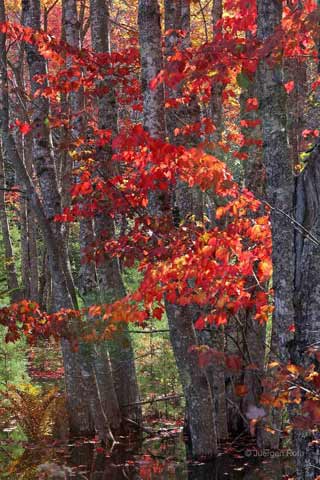
Black Birch Tree Splendor along Route 233;
Camera settings f/11, 1/10 sec., ISO 100
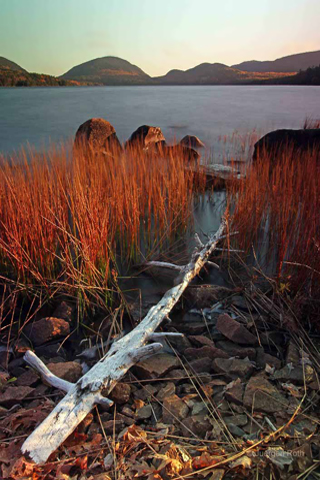
Eagle Lake in Autumn;
Camera settings f/20, 30 sec., ISO 100
Eagle Lake is also a great sunset photography location. There are rocks, logs, and grasses along the shore that provide wonderful compositional elements that make for great waterscape photography. Across the parking area is a little pond with plenty of wildlife, such as otters, dragonflies and frogs.
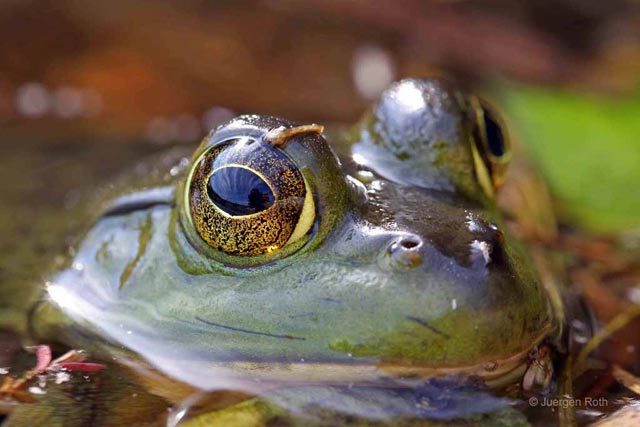
Pond Celebrity; Camera settings f/8, 1/8 sec., ISO 100
Back Roads Off Route 102, Carriage Roads, and Hiking Trails
The back roads off route 102 provide deep forest terrain for exceptional forest photography on overcast days. Duck Pond and Hodgdon Brook allow for beautiful cascades and leaf covered rocks during autumn.
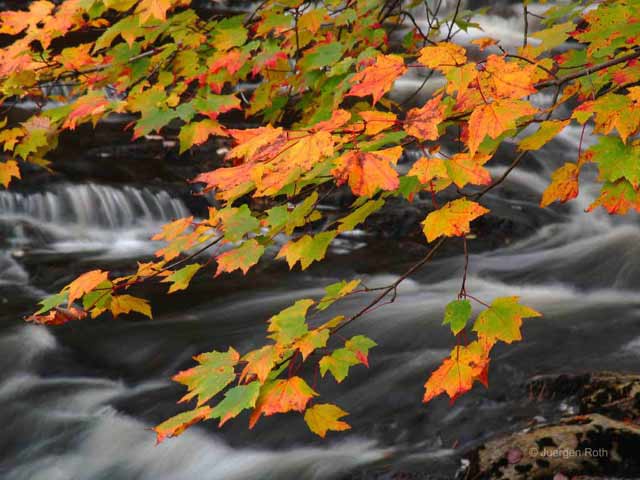
Autumn Burst; Camera settings f/8, 1 sec., ISO 100
Along the “Around the Mountain” carriage road there are a few great waterfalls and cascades that can be photographed. Eliminate boring gray skies from your composition and zoom in for more intimate landscape photography pictures. Bring a ND filter and polarizing filter to extend exposure times to eliminate glare on leaves and water surfaces and to create smooth water effects.
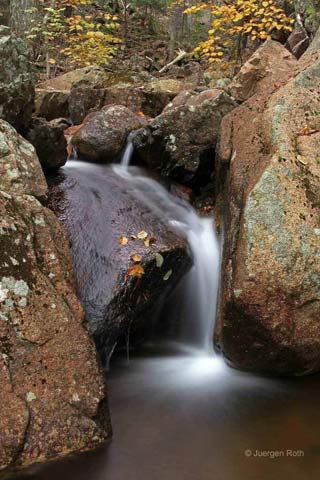
Waterfall in Acadia National Park;
Camera settings f/22, 10 sec., ISO 100
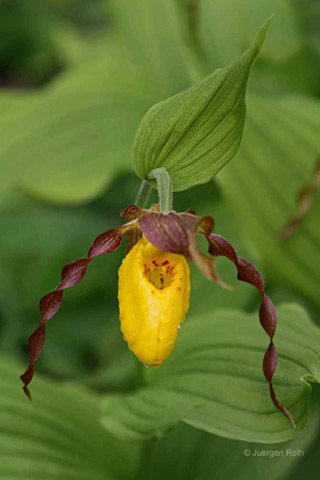
Yellow Lady Slipper
Wild Gardens of Acadia;
Camera settings f/5.6, 1/200 sec., ISO 100
Photo Tip:
There are rumors that moose and black bear call these forest areas their home. I have not encountered such wildlife here yet, but early morning and late afternoons will heighten your chances. Good luck!
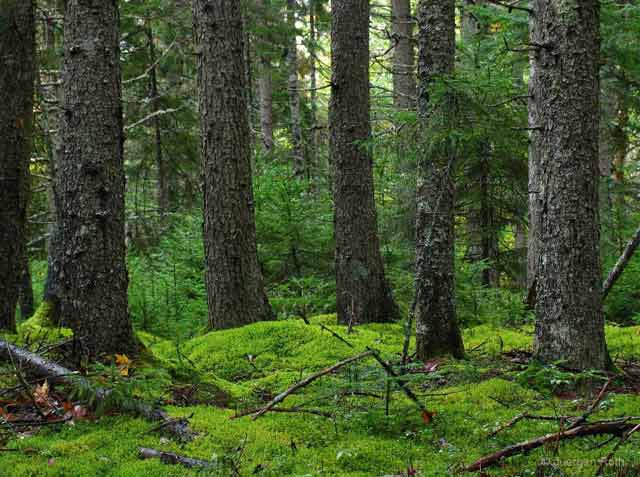
Lush Green Forest of Acadia National Park; Camera settings f/5.6, 1 sec., ISO 100
Wonderland Trail
Wonderland Trail is a 0.5 mile trail in Acadia National Park that leads out to a rocky coastline. It is pristine at low tide for macro photography or at morning and evening for sunrise and sunset photography. Once at the ocean, there are several spots to merely sit and enjoy all that is around you, or take nature photographs.
Photo Tip:
Make sure to plan your trip at low tide since this allows for exploration of the tide pools and their marine life. If you are lucky you may encounter a star fish on one of these black rocks ~ something I always come back for, year after year!
PHOTO GEAR FOR THE TRIP
I always bring a tripod for higher photo quality and a set of different lenses, such as a wide-angle lens, telephoto lenses, a 1.4x telephoto extender, and a macro lens for tiny landscapes. Polarizing filter, neutral density filter and split neutral density filter are important for bold colors, silky water effects or stunning seascape and landscape images. Lots of battery power and memory cards are necessary accessories that you do not want to run out off, so bring plenty as there is no shortage of captivating inspiration for your photography.
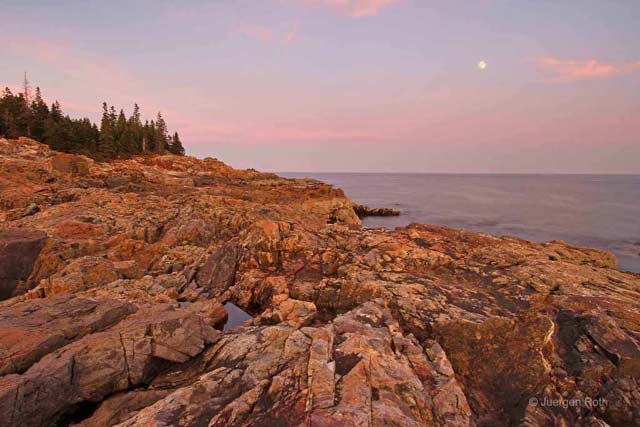
Full Moon over Acadia National Park; Camera settings f/18, 4 sec., ISO 100
Acadia is worth a visit at any time of the year. In the late spring you’ll find the brooks and waterfalls carrying more water and the area is coming back to life from another New England winter. Summer comes with plenty of fog and beautiful blue skies and clear nights while fall, around mid-October, will unleash an unforgettable autumn glory.
Good light and happy photo making!
by Juergen Roth
All text & photos: © 2013 Juergen Roth. All rights reserved.

Mr Roth – Your grasp of what to shoot in Acadia is awesome. I’m going to Acadia this Fall, ( Dad lives nearby in Augusta ) , and will re-read your articles again to be better prepared and can’t wait to satisfy my creative image craving. Thank you so much for the inspiration and highly detailed comments . Jeff Urquhart